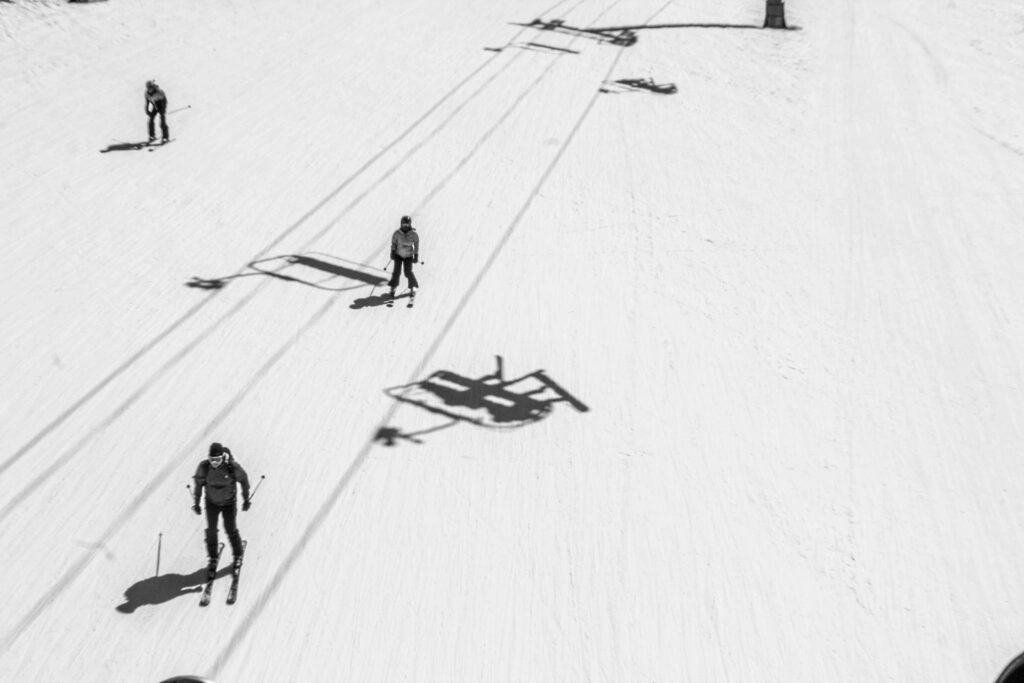Top Intermediate Ski Tips for a Superior Ride

The exhilaration of conquering the slopes, the rush of the wind against your face, the pure joy of skiing – it’s an experience unlike any other. But what if we told you that there’s more to discover, more heights to conquer, more exhilaration to be felt? Yes, you, the intermediate skier, are on the precipice of unlocking a whole new level of skiing prowess with these intermediate ski tips.
Key Takeaways
Understanding the Intermediate Skier

An intermediate skier, by definition, is someone who has already mastered the basics of skiing. This skier can confidently tackle red runs and is eager to continue learning and improving their skills on the slopes. However, progressing as an intermediate skier involves more than just honing technical skills. It requires a strong foundation in intermediate skiing, which includes:
adopting the right mindset
a fusion of mental strategies
solid motivation for skill enhancement
a readiness to venture beyond mere descent skiing.
The key to transitioning from intermediate to advanced skill levels is frequent practice. The more you ski, the more you reclaim your ‘ski legs’, ‘ski eyes’, and ‘ski brain’, which are crucial for honing your technique and reaching higher levels of skiing capability. It’s a journey of constant learning, breaking old habits, and forming new ones. But with every new skill mastered, there’s a great feeling of accomplishment waiting at the end of the slope.
Essential Ski Gear for Intermediate Skiers

Having the appropriate gear significantly influences your skiing experience. Upgrading your ski gear can accelerate your progress as an intermediate skier, preparing you for the transition to becoming an advanced skier. If you’re looking to maximize your performance and enjoyment on the slopes, consider these best skis:
These models are known for their exceptional performance and versatility, making them ideal ski boots for intermediate skiers in need of a reliable ski boot.
But what about the cost? Don’t worry, there are plenty of ways to upgrade your gear without breaking the bank. Here are some options to consider:
Check out used gear exchanges like Gear Trade
Explore flash deal sites like Steep and Cheap
Attend gear swaps and visit ski shops that sell the previous season’s demo gear
It’s all about making smart choices and investing in the right gear to improve your performance on the slopes.
Proper Body Positioning for Better Control
In skiing, maintaining a proper body posture is paramount. Maintaining the correct posture is essential for controlling speed, and direction, and adapting to slope conditions effectively. One common mistake many intermediate skiers make is leaning back, which can cause you to speed up and feel out of control. Instead, lean forward to engage the front edges of your skis, giving you more control over your speed and direction.
Gaining proficiency in rotation and angulation can further improve your balance and stability. These techniques help you maintain balance and control speed, while also allowing you to dig in the edges more strongly, providing better balance and control. And don’t forget about the importance of knee flexibility. Bent knees act like shock absorbers, helping you adapt to any terrain and engage your core for quicker responses and better control.
Mastering Ski Techniques: From Intermediate to Advanced
Having addressed the basics, we can now delve into the more detailed aspects. The next step in your journey to becoming an advanced skier is mastering key ski techniques. By focusing on one technique at a time, you’ll gradually improve and before you know it, you’ll be skiing like a pro. Some key ski techniques to master include:
Carving turns
Parallel skiing
Mogul skiing
Practice each technique individually and then combine them to become a well-rounded skier.
Pole Planting
Pole planting is a crucial technique that can considerably enhance your balance and control when using ski poles. Mastering the proper pole planting technique is the key to achieving better balance and control, which are essential for taking your skiing skills to the next level. A strong pole plant can mentally signal your commitment to the next turn and help develop the forward-leaning posture that’s important for good skiing technique.
When you perform a pole plant, follow these steps:
Reach out and confidently plant the pole down the hill in front of you.
This involves a slight torso bend toward the planting side and a concurrent hip sway in the opposite direction, resembling a graceful dance move.
By combining pole planting with bent knees, you’ll gain agility and control, preparing yourself to conquer any challenges you may face on the slopes.
Carving Turns

Carving turns is another technique that warrants your mastery. Carving turns are all about aggressively using the edges of your skis to bite into the snow, instead of just steering or skidding around the turn with a weight shift. This technique can significantly improve your control and rhythm, making your skiing experience smoother and more enjoyable.
To perfect your carving turns, follow these steps:
Start with a strong stance and let your skis do the work.
Gradually challenge yourself on different terrains as you gain confidence.
Focus on maintaining balance and control.
When it comes to body positioning, ensure your upper body is aligned for longer, more carved turns.
Lean into the turn while staying centered above your hips.
You should aim to practice carving turns on intermediate terrain slopes, as they offer the perfect balance of difficulty and control for your learning journey.
Pressure Management
Mastering pressure management is also an important technique for you to consider. It’s all about controlling and distributing pressure on your skis, which allows you to:
Control edge angles
Stay balanced
Maintain stability
Enhance your skiing performance and overall experience
By effectively managing pressure, you can resist accelerating forces and maintain balance and maneuverability in various skiing situations.
To enhance your skiing experience, try:
Applying pressure to bend and turn the skis
Standing over the ball of your foot to pressure the tips
Controlling rotation with leg rotation separate from the upper body
Practicing good pressure control drills such as the one-ski technique
Optimizing edging by pressing the hands downwards on the knees while maneuvering
By mastering ski pressure management, you can unlock your full potential on the slopes and have a smoother, more enjoyable skiing experience.
Expanding Your Comfort Zone: Challenging Terrain and Conditions

Having gained a solid foundational understanding and mastered the basics, it’s time for you to push your boundaries and take on challenges. Skiing in varied terrain and conditions can help you develop adaptability and improve your overall skiing skills. But remember, it’s important to stay within your ski abilities and avoid tackling slopes that are too advanced for your current skills, as this can lead to injuries and setbacks.
As you push your boundaries, don’t forget to keep things safe and enjoyable. Here are some tips to help you navigate through trickier terrains:
Start small and gradually progress to more challenging slopes
Avoid steep slopes or areas with obstacles such as rocks or trees
Focus on building confidence and boosting your skiing skills with each new challenge you conquer
By following these skiing tips, you can ensure a safe and enjoyable experience.
So go ahead, push your limits, and unlock a whole new level of advanced skiing prowess.
Building Strength and Endurance Off the Slopes
Given the physically demanding nature of skiing, it necessitates both strength and endurance. Off-slope exercises and activities can greatly enhance your skiing performance and reduce post-skiing soreness. As an intermediate skier, you should focus on building strength, especially in the hips and core, to enhance your control and stability on the slopes. This will not only improve your skiing capabilities but also lower the risk of injuries.
To enhance your skiing endurance, consider the following exercises:
Running
Stair climber
Elliptical trainer
Lateral lunges
Step-ups
Gorilla row
These exercises can contribute to building cardiovascular fitness and leg strength. Remember, skiing doesn’t just start and end on the slopes. The work you put in off the slopes can greatly impact your performance on the slopes.
Learning from the Pros: Ski Instructors and Ski School
Guidance from a professional ski instructor can greatly expedite your skiing progress. Professional ski instructors have undergone specialized training courses and met strict criteria established by esteemed organizations like the Professional Ski Instructors of America (PSIA) and the American Association for Snowboard Instruction (AASI). They provide expert guidance, teach proper technique, ensure safety, create a progression plan, and offer immediate feedback, all of which can help you improve your skiing skills.
If you’re serious about taking your skiing to the next level, attending ski school can be an excellent investment. Ski schools offer group lessons tailored to address specific needs, provide invaluable mental advice, and equip skiers with drills to conquer more challenging runs. While the cost of ski school can vary depending on the resort and the duration of the lessons, the average cost for intermediate skiers can range from $175 to $300 for group lessons. The skills and confidence you gain will be worth every penny.
Overcoming Common Intermediate Skier Mistakes

Correcting any existing mistakes is as important as focusing on acquiring new skills. One common mistake many intermediate skiers make is incorrect knee positioning. This can significantly increase the risk of knee injuries, cause anterior knee pain, limit your range of motion, and reduce stability and control. By focusing on maintaining proper knee positioning, you can maximize your stability and control on the slopes.
Another common mistake is over-terraining, which is when skiers tackle slopes that are too advanced for their current abilities. For intermediate skiers, avoiding over-terraining is crucial for safety and for making progress in skill development. Remember, it’s not about how fast you can go, but how well you can control your speed and direction. Focus on mastering the basics and gradually build up your skills, and you’ll be on your way to becoming an advanced skier.
Mental Preparation: Confidence and Relaxation
While enhancing your physical prowess, remember to pay attention to the psychological elements of skiing. Building confidence, staying relaxed, and maintaining a positive mindset are all crucial for a great skiing experience. A positive mindset can accelerate the absorption of new techniques and equip you to conquer challenges on the slopes with unwavering resilience.
Staying relaxed while skiing has incredible benefits. It allows you to:
Engage the right muscles at the right time
Maintain suppleness
Develop proper body angles during turns
Make turning easier
Overcome fear and maintain focus
This leads to better performance on both the uphill ski and downhill ski slopes, especially when following the fall line.
Remember, skiing is not just a sport, it’s a state of mind. Embrace the challenge with a positive mindset, and you’ll be amazed at what you can achieve.
Making the Most of Your Ski Trip
With your skills and mindset in place, you can now proceed to plan your ski adventure. Choosing the right ski resort can significantly enhance your skiing experience. Look for ski resorts with at least 200km of pistes, as these resorts offer a variety of runs to help you advance your skills. The prime time for intermediate skiers to plan a ski adventure is typically in mid-January due to thinner crowds, excellent snow conditions, and more affordable accommodations.
Planning a ski trip doesn’t have to break the bank. There are plenty of ways to maximize your ski adventure on a budget. Here are some tips:
Avoid peak travel times and high-demand resorts
Opt for accommodation in neighboring towns
Look for ski packages and deals
Consider group ski trips for shared costs and potential group discounts
Take advantage of group lessons to improve your skiing abilities
By following these tips, you can have an amazing ski trip without spending a fortune.
Summary
In conclusion, skiing is a journey of constant learning and improvement. From understanding the basics and upgrading your gear to mastering techniques and pushing your limits, every step you take brings you closer to becoming an advanced skier. Remember, it’s not just about the physical skills, but also the mental preparation and the experiences you gather along the way. So put on your ski boots, grab your poles, and hit the slopes. The mountains are waiting for you to conquer them.
Frequently Asked Questions
How can I improve my intermediate skier?
To improve your intermediate skiing skills, focus on separating your movements at the hips to maintain control, traction, and downhill focus, allowing for tighter turns and smoother cruising. Happy skiing!
What is considered an intermediate skier?
An intermediate skier is considered to be at Level 3, being able to tilt their skis onto their edges, control speed and direction well on most pistes, and feel prepared to ski steeper black pistes and easier off-piste descents. With these skills, intermediate skiers can confidently navigate a variety of terrains on the slopes.
How do you stop on intermediate skis?
To stop on intermediate skis, roll your feet and knees toward the hill, driving your weight into the ski edges to bring your body to a stop. You can also try foot rotation or a hockey stop technique.
How do you turn on intermediate skiing?
To turn on intermediate skiing, focus on improving pressure and balance, which will help you control your turns and maintain stability on the slopes. By working on these skills, you’ll be able to navigate more challenging terrain with confidence. So, put in the effort to improve pressure and balance, and you’ll soon see progress in your skiing abilities.
Why is body positioning so important in skiing?
Having the right body positioning in skiing is crucial for maintaining balance, controlling speed, and adapting to different slope conditions effectively. It’s all about finding that perfect balance and control to navigate the slopes confidently.






